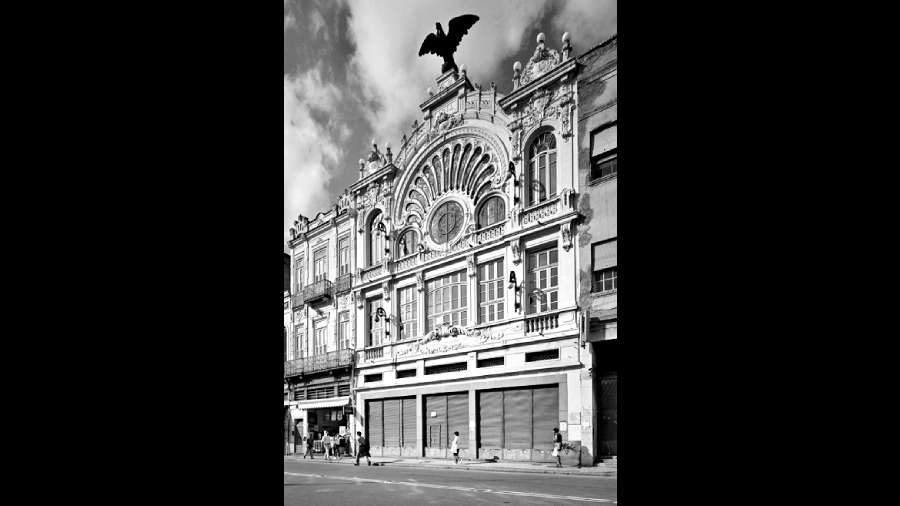Calcutta’s connection with Brazil is of the soul. You don’t need no X-ray vision to be able to spy that umbilical cord made up of Pele, Garrincha, Ronaldo, Zico, Ronaldinho, Neymar and so many others in between. But Building Brazil, an exhibition of 200 photographs organised on the 200th year of Brazil’s independence at Calcutta’s Indian Museum, is not about football.
Brazil’s ambassador to India, Andre Aranha Correa do Lago, who curated the exhibition, says, “The strongest character of a civilisation is its built architecture. What a society builds — hospitals, houses, museums, stadiums — says a lot about the country. Information about Brazil is limited to its politics and football. Through this exhibition, the people of Calcutta will know how Brazil, like Calcutta, has its share of 19th century European architecture. Then, of course, Art Deco buildings abound both in this city and in Brazil. Brazil’s modern architecture also influenced early modernism in India. In fact, we could have a parallel exhibition on the commonalities of Calcuttan and Brazilian architectures.”
Brazil has clearly defined eras in its political and social journeys, and these intertwine with architectural styles — beginning with the monarchy (1822-1889), the first phase of the republic (1889-the 1930s), the industrialisation and urbanisation, strong population and economic growth phase (1930s1984) and the New Republic (since 1985). While football and sports have contributed to the building of its infrastructure, and stadia, the stages of its economic development and cultural assimilation have also left their mark on the built legacy of the nation. This particular exhibition showcased the South American nation’s buildings from 1822 to the 1930s through the lens of Cristiano Mascaro. The buildings from the 1930s to 2022, which showcase the modernist movement and contemporary architecture, have been photographed by Lenardo Finbotti.
A black-and-white shot of a road with a skyscraper office building of 1920s vintage in São Paulo by architect Vilmos Filinger sets the mood for the architectural sojourn. There are also photographs of train stations, fire brigade headquarters, a street photograph of Manaus, the opera house and Theatre in Rio de Janeiro. “For almost 70 years of monarchy, Brazilian emperors replicated in their tropical country the architectural styles found in Europe at the time, starting with neo-classicism. By the mid-19th century, one could easily spot several buildings in the diverse European styles in Brazil,” says do Lago.

Theatre, Fortaleza
Becoming a republic in 1889 paved the way for the adoption of a new architectural style — eclecticism. “Many public buildings such as train stations, markets, theatres and gazebos were imported in large pre-fabricated steel parts and assembled in Brazil and installed across the territory. These works remain and showcase a European industrial architecture that is also present in India,” do Lago adds.
A 1900 central market in Belem by architect Henrique La Rocque is a fine example of wrought iron work and lattice that is commonly seen in India. A 1905 Art Nouveau house in Manaus with its prominent arches over white louvred windows and doors juxtaposed against the colourful mosaic floor shows the assimilation of various influences. Photographs of Art Deco buildings are in abundance. “Art Deco not only shows the modernity of society but also allows the incorporation of indigenous references,” reads a caption.
In 1922, the art festival in São Paulo, the Modern Art Week, started the debate on how to create a “nationalistic modernism” that can reflect a country looking to the future. Intellectuals proposed anthropophagy (cannibalism) as a symbol of a country that can absorb all kinds of influences from indigenous peoples, Portuguese colonialists and immigrants. It was only after the 1930s that the ideas of Modern Art Week began to show and Brazil, thereafter, was no longer an importer but an exporter of architectural ideas. A street photograph from 1934 shows apartment buildings in São Paulo that are a marked departure from European influences and represent the new modernity of Brazil.

Department store, Rio de Janeiro
The new generation of architects is exploring more contemporary paths with sustainable practices. The exhibition shows the evolution through the recent works of more than 30 contemporary architects.
Brazil played a central role in shaping 20th-century architecture and because it did not belong to the club of wealthy nations with a long tradition of architecture, according to the ambassador, critics found it difficult to give due recognition to a peripheral nation’s merit.
The World Cup and Olympics drove a number of infrastructure projects and the many projects built especially for the prestigious sports events brought new talent to the fore. The airport in the state of Santa Catarina is one such structure that came about because of the mega events held in Brazil, the Sustainability Pavilion for Rio+20 is another example. The football stadium in Porto Alegre in the state of Rio Grande do Sul is yet another one. Says do Lago, “Because of Calcutta’s football connection to Brazil, we especially included the stadiums.” Come November, watch Calcutta respond.
Photographs by Cristiano Mascaro and Leonardo Finotti











